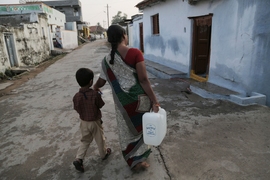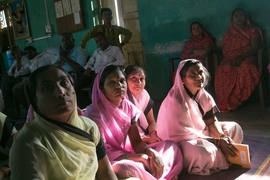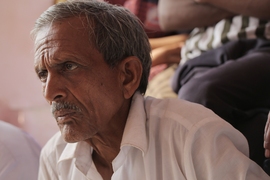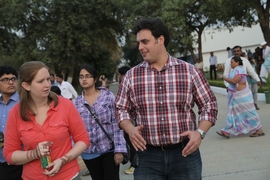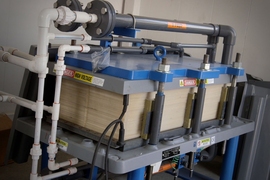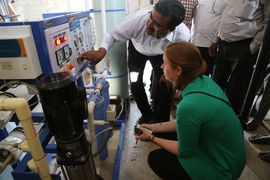The air was hot and gritty. Shehazvi had to squint to see past the sun into the edge of town, past the cars and motorcycles whizzing by, past the scorched earth, to where old buildings stood beautiful in their own way, muted pinks and oranges still curving and curling in all the right places. No rain again today.
She and her daughter climbed out of the rickshaw and walked down the alley that leads to their home, 200 rupees lighter than when they left for Jalgaon city earlier that day. That’s how much it cost every time she took her daughter to the doctor for stomach pains. The culprit? The salty drinking water.
“Excessive salt intake can be quite detrimental to one’s health, both in the short and long term,” says Maulik D. Majmudar, a cardiologist at Massachusetts General Hospital.
But there is no grocery store in Shehazvi’s rural Indian village where she can stock up on bottled water. There is no on-demand tap of drinking water that’s already been prepared for her safety and comfort. There is no reliable electricity.
The cost of clean water
Shehazvi is a teacher and resident of Mhasawad, a village of about 8,400 people that flanks the Girna River in Maharashtra, India. Unable to watch her daughter suffer further pains from drinking salty water, she recently started paying 30 percent of her monthly income to receive treated water from a reverse osmosis (RO) plant. With an average salinity 75 percent lower than that of the untreated town water, the treated water is worth the cost to Shehazvi.
“The water that is supplied is contaminated, and my daughter was always in pain,” she says. “I had to repeatedly take her to the doctor in Jalgaon, and it was very expensive. So I started buying filtered water. Now the stomachaches and the illnesses are gone.”
But despite the benefits, most of the residents of Mhasawad can’t afford RO water, from which bacteria and salt have been filtered out, and thousands of people in the village regularly drink water with a salinity level above 1,200 parts per million (ppm). To put that into perspective, the World Health Organization recommends levels under 600 ppm, and the water in Cambridge, Massachusetts, usually doesn’t get above 350 ppm at its worst.
“Everyone wants to drink the clean water,” Shehazvi says. “But what do they do if they can’t afford it? I only get paid 2,000 rupees per month and buying this water has been difficult.”
If the lower-income households can’t afford the RO-treated water, they definitely can’t afford the health costs associated with drinking salty water. One man living in Mhasawad says he spends around 20,000 rupees a year on his kidney stone problem.
The townspeople of Mhasawad are particularly concerned about the health of their children, who, according to the teachers in the village, including Shehazvi, have continuous digestive problems and stomach pains that often distract them during school lessons. When the pain gets bad enough, the teachers have to send the children to the hospital during school.
Convergence of perspectives
In order to design a water treatment system that was affordable and would actually work in the context of rural Indian villages, Amos Winter, an assistant professor in the Department of Mechanical Engineering, and PhD candidate Natasha Wright, a researcher in Winter’s GEAR Lab and a fellow of the MIT Tata Center for Technology and Design — which supports this and other GEAR Lab projects for the developing world — knew they first had to develop an in-depth understanding of the problem by talking directly to the residents themselves.
“We are in the field every six months trying to figure out how socioeconomic factors influence technical factors,” Winter says. “We walk the lines between product designers, machine designers, ethnographers, and social scientists, and it’s at the convergence of all those perspectives that disruptive new solutions come together.”
In August 2012, Wright travelled to Jalgaon to meet with engineers at Jain Irrigation Systems and partner on the development of a system that would set in motion the company’s dream of providing poor villages in India access to affordable potable water.
The company’s plan was to develop affordable home water systems that would remove the biological contaminants from the water, and Wright’s first two trips to Jalgaon were spent researching which systems were already on the market and how they were working.
“I went to villages and interviewed women’s groups, men’s groups, and individual families,” she says. “I was focused on the removal of biological contaminants and was hearing that a lot of villagers had filters but weren’t using them regularly. I wanted to figure out how to improve the water and increase the likelihood of filter use to prevent sickness.”
“When I reviewed my survey results,” she continues, “I realized that everyone was complaining about salt, even though I never even asked about it. They said it tastes bad, leaves marks on their pots and pans, and makes their stomachs hurt.”
“As outsiders, our motivations are often fueled solely by health concerns,” Winter says. “And of course that is crucial, but you have to remember that villagers have almost always gotten their water for free. So to go to a person and say we want you to pay for water that basically looks and tastes the same — what’s the value added to them? It’s our job to figure out why people would choose to buy clean water and include it in our solution.”
Wright and Winter believe that by designing a community system that can provide tasty, desalinated water at an affordable price, all villagers — especially those who are poorer and tend to drink contaminated, high-saline water on a regular basis — will be more likely to consistently drink water that’s clean and healthy, even if they have to pay for it.
Not much water anywhere, and not a drop to drink
The issue goes much deeper than taste. About 50 to 70 meters deeper, in fact. That is the depth at which many villages in India have to dig new wells to access any water at all.
India’s climate is hot and dry for most of the year, and the country as a whole is overcrowded. With almost 1.3 billion people and counting, it has the second-highest population in the world, and rainfall is mostly isolated to the three-month monsoon season. So while the demand for water increases with population, the water remains scarce, and many places like Mhasawad are forced to dig into the ground for water.
But as water is removed from the ground, the water table — which is dependent on the amount of rainfall — lowers as it becomes overdrawn but not replenished. The aquifers get deeper and deeper to access more water, and the salinity level of the water often naturally increases with depth.
So it’s an understatement to say that water is precious and can’t be wasted. And yet that’s exactly what happens when RO systems are used with the water in these areas.
RO systems work by utilizing a high-pressure pump to push water through a membrane; the saltier it is, the more energy that’s required to move the water through. The problem is that after the first pass through an RO membrane, the now-pure water has been removed and what’s left is concentrated saltwater.
And now that it’s more concentrated, it requires proportionally more power to move it through the membrane — so much more that the cost of the power outweighs the benefits, and manufacturers forgo a second pass to keep the costs down.
As a result, many RO systems in this area have enormous water reject rates. For example, in Chellur, a city outside of Hyderabad, the reject rate is approximately 70 percent — meaning that 70 percent of potential drinking water is wasted before it ever gets desalinated.
Enter solar-powered electrodialysis
The way Wright and Winter see it, they have to engineer a system for low cost, low waste, and low energy consumption. It is a mighty tall order indeed, and certainly one that can’t be fulfilled just by simplifying a solution that already exists in a developed country.
They started by identifying a system that would work best for the salinity of brackish groundwater in these rural villages. They chose electrodialysis reversal (EDR), because at the area’s typical salinity level of 500 to 2,000 ppm, it requires 25 to 70 percent less energy than RO and can recover more than 90 percent of the feed water.
EDR, which has been commercially available since the 1960s, works by pumping feed water through a stack alongside alternating cation and anion exchange membranes. When a voltage is applied across the stack, anions in the water are pushed toward the anode but are blocked by the cation exchange membranes, which only allow cations to cross, and the opposite is true for the cations. In this way, the salt is separated from the feed water and the resulting concentrate stream is recirculated until it is too salty to continue and is pumped into a nearby evaporation pond. Wright’s system utilizes UV light to kill biological contaminants in the water as well.
Because water is not being forced through a membrane, the required pressure and relative pumping power is much lower than in RO systems, and Winter and Wright can save energy as a result. This energy gain also opens the door to affordable solar-powered desalination systems, because now they don’t need as many solar panels.
So the researchers have replaced grid electricity with solar power and can bypass the unreliability of the Indian electrical grid altogether, decreasing operational and capital costs at the same time. Because EDR uses stacks of exchange membranes that only have to be replaced every 10 years, and that don’t require any filters, they cut down on the maintenance costs by eliminating the need to replace membranes or filters often.
The capital costs of their photovoltaic (PV)-EDR system will depend on whether they’re able to manufacture their own stacks, but they are targeting a one-time investment of around 755,000 rupees, which is equivalent to the cost of current community on-grid reverse osmosis systems.
In Bahdupet, outside of Hyderabad, the local government pays approximately 7,600 rupees per month to power its village RO system, pay the plant operator, and replace filters and cartridges, incurring no loss but making no profit. Switching to Wright’s system could cut their monthly costs almost in half, and they could reinvest the savings back into their town and its people.
Solving the solar power problem
Wright and Winter have designed, built, and tested their prototype system, and their next step is to implement it in a village outside of Hyderabad, where the people are currently using a village-scale RO system that was originally sold to them on loan from a local company called Tata Projects. Wright and Winter have partnered with Tata Projects to help the company improve their village-scale water desalination systems and potentially transition from their current RO systems to the PV-EDR systems Wright is designing.
Meanwhile, Wright is looking into ways to make the system more efficient — for example, using alternate architectures for the EDR stack. At the same time, she is working with fellow GEAR Lab graduate student David Bian and Sterling Watson, a student in the MIT Photovoltaic Research Lab, to cost-optimize the combined solar power and EDR system. Currently, the solar panels are equipped with batteries to store extra solar power and distribute it evenly throughout the day, but they are investigating alternative designs that may allow the solar panels to connect directly to the EDR stack.
“If we can solve that problem,” Wright says, “we can potentially provide about 250 million people in India who currently drink salty groundwater a safe and affordable source of water.”
The MIT Tata Center catalyzed GEAR Lab’s desalination work and, along with Jain Irrigation, enabled them to enter and win last year’s USAID Desal Prize. GEAR Lab has also received funding from Tata projects, USAID, and UNICEF for this work.
Join Professor Winter and Natasha Wright for a live Reddit AskScience AMA (Ask Me Anything) on Wednesday, July 20 at 4 p.m. EDT.
